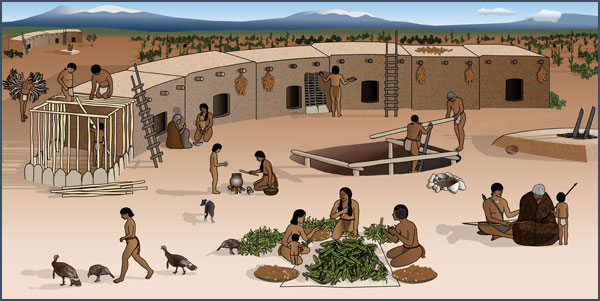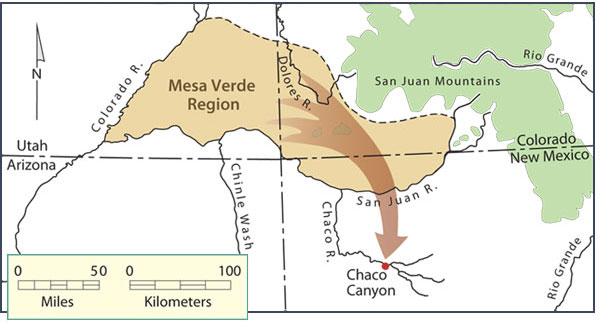Peoples of the Mesa Verde Region
The Pueblo I Period: A.D. 750 to 900Overview
For the last two centuries, the people of the Mesa Verde region have been living on small farmsteads scattered across the landscape. But by the end of this period, most are residents of much larger settlements, with dozens—if not hundreds—of near neighbors. 
A Pueblo I farmstead, including aboveground rooms and two belowground pithouses. To see what a Pueblo I pithouse looked like on the inside, go to Housing. During the Pueblo I period, large villages of up to several hundred people came into existence. Although communities were known from the earlier Basketmaker III time period, they had consisted primarily of clusters of small farmsteads. In contrast, by the end of the Pueblo I period, the majority of people were living in densely populated villages, some quite large. 
Late Pueblo I communities consisted of densely populated villages and a few scattered farmsteads.
Pithouses continued to be built throughout the Pueblo I period, but people increasingly spent part of their time in structures built aboveground, structures that included both living space and storage space. Large public buildings became more common, which may indicate that society was becoming more complex. Archaeologists believe that religious, economic, and political institutions were developed during this time to deal with large numbers of people living near one another. At the very end of the Pueblo I period, after many decades of population growth, there was a sudden decline in population throughout much of the Mesa Verde region. The decline may have been associated with warmer and drier conditions that made it difficult for the Pueblo farmers to grow corn. Some people moved to higher-elevation areas along the northern edge of the Mesa Verde region, where there was more moisture. But it appears that many people left the area altogether. Where did they go? According to Pueblo oral tradition, people moved to areas south of the Mesa Verde region. Archaeological evidence indicates that people from the Mesa Verde region emigrated to present-day New Mexico, in and near Chaco Canyon—an area that was to play a pivotal role in the developments of the next period. 
At the end of the Pueblo I period, many people moved south, probably to areas in and near Chaco Canyon in present-day New Mexico. |
|
Acknowledgments | Illustration credits | To borrow, cite, or request permission | Please take our survey! Title page for Peoples of the Mesa Verde Region |
|
 DONATE TODAY
DONATE TODAY
